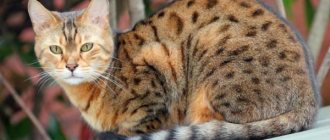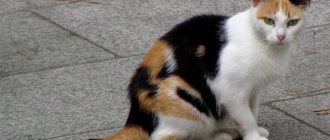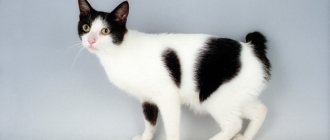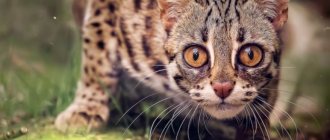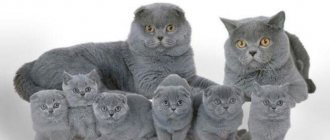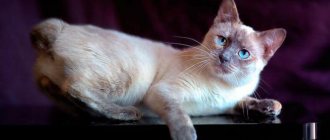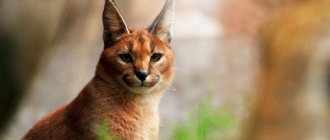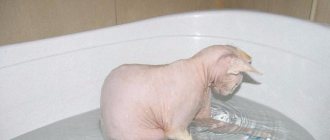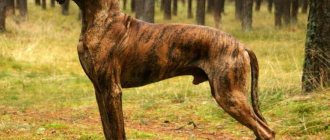American Wirehair cat
The American wirehair cat is quite rare to find even in their homeland, but if you buy one, you will not regret it. Like other American cats, the Wirehair is suitable for people and families.
She will be both a cozy house cat curled up at your feet and an energetic outdoor cat who tirelessly plays with children. A medium-sized wirehaired cat, muscular, with a solid, well-proportioned body.
It received its name for the thick and dense fur that appears in kittens born from ordinary domestic cats.
History of the breed
As you can easily guess from the name, the American Wirehair cat breed comes from America. It all started as a spontaneous mutation among a litter of kittens on a farm near New York in 1966.
Two identical short-haired cats who suddenly gave birth to kittens that were unlike them. Such events in nature, although rare, do happen.
But what happened next definitely does not happen in nature. Interested owners showed these kittens to a local cat breeder, Miss Joan Oshia.
She purchased the kittens for $50, along with one of the regular kittens that was in the litter. And she began selection work.
The first American wirehair cat was named Adam, and the cat was called Tip-Top, because the other kittens were killed by weasels.
Interestingly, neither before nor after this event, there were no reports of similar mutations among shorthaired cats. But Joan faced a problem: how to get offspring with similar hair?
And chance intervened again. The neighbors had a cat, which they took care of, but somehow went on vacation, leaving it with their son. Adam was walking by himself at this time.
So, two months later, a call rang in Joan’s apartment; these neighbors reported that kittens had been born, some of which had the same fur as Adam’s.
The gene turned out to be dominant and was passed on from parents to kittens. This is how a new breed of cats appeared.
Interesting facts about the breed
- The ancestor of the exclusive wire-haired breed is considered to be a white-and-red kitten named Adam, the only surviving specimen in the litter. A rare, amazing cat that appeared on a US farm, thanks to the breeding work of breeder Joan O'Shea, gained recognition in America, Europe and is becoming popular in Russia.
- Sometimes, in a litter of 5 kittens, not all of them retain hereditary characteristics; babies may appear without obvious wire-haired characteristics, which is discovered after 3 months of development.
Cats, American Wirehair cats, an original, exclusive breed, are a good choice for purchasing for a family. They will be a joy for everyone in the house. The pet will captivate you with its friendly, affectionate character and friendly attitude not only towards its owner. The docile animal becomes attached to members of the entire family and responds well to affection and attention. They are clean, well tamed to order, they are kept without hassle, both in apartments and in private motorcades.
Description
In appearance, the Wirehair cat is similar to the American Shorthair, with the exception of the hair, which is elastic and coarse. It resembles the fur of some dogs, such as terriers. It does not require much care, although light-colored cats should be hidden from strong sun.
Wirehair cats are medium in size, with a strong body, rounded head, high cheekbones and round eyes. The eye color is golden, with the exception of some white colors, which sometimes have blue or amber eyes.
Female cats are smaller than males, which weigh 4-6 kg, and male cats weigh no more than 3.5 kg. The lifespan of a wirehaired cat is about 14–16 years.
The color can be varied, although chocolate and lilac are not allowed in competitions.
The gene that transmits wirehair is dominant, so any litter contains kittens with wirehair, even if one of the parents is of a different breed.
wirehair cats
When you see an American Wirehair cat, you get the impression that its entire body is covered with short pieces of “thin curled wire.” But don’t believe your eyes - pet the animal and you will feel how soft and silky cat curls are.
The standards for this breed are generally similar to those for the American Shorthair:
- The animal should be medium or large in size with a well-developed muscular body: a massive head and strong paws create the impression of strength and endurance. The American Wirehair cat is really full of energy, loves to play and is an excellent hunter.
- Tassels are allowed on the ears, making the cat look like a lynx.
- The eyes are golden or amber, large and expressive.
- The color of the coat can be any color except lilac and chocolate (a cat can be disqualified at a competition for having too long hair or “saggy” cheeks).
Character
The American Wirehair is a good-natured cat and is popular among families as it is very tolerant of children.
Calm, she remains playful even in old age. Cats are more active than cats, but in general they are smart, curious animals that are interested in everything that happens around them.
They realize their hunting instincts on flies that are foolish enough to fly into the house.
They also love to watch birds and stare out the window.
They love the company of people, but at the same time maintain independence.
Personality: active and inquisitive
American Wirehair cats have gained popularity in the United States due to their amazing personalities. These pets are playful, charming and friendly. You can get them in a large family, where there are small children with whom the animals get along well, as well as in a small one, if the owners are constantly at work. Despite the fact that the cat is sociable and loves the attention of its owners, in their absence it will find something to entertain itself. Therefore, experienced breeders recommend providing the cat with as many toys as possible, setting up a house for him, and making sure there are climbing frames. If there are no toys, the wire-haired cat will find them himself. Pets do not hesitate to throw improvised objects from surfaces or climb into packages or bags.
The funny pet gets along with his own and strangers.
The wire-haired cat treats well not only its owners, but also strangers. When guests arrive, the pet does not hide, but prefers to get to know the newcomers. The same applies to having other pets in the house. A wire-haired cat will make friends with its brothers, dogs, and rodents. An aquarium with fish seems to hypnotize the American wirehair cat; she can watch it for hours. However, there is no need to worry that the fish will be caught soon, since the pet is afraid of water.
Maintenance and care
Feeding a wirehaired cat is no different from feeding other breeds and there should be no problems with it.
You need to comb it once a week, without making much effort. Because of their oily skin, some cats need to be bathed more often than other breeds, using cat shampoo.
There is no need to be afraid that its fur will change shape. It will dry and return to its normal position, as it is elastic and elastic.
But you need to carefully monitor your ears. The fact is that her fur also grows in her ears, and it is also quite thick. Accordingly, you need to regularly clean your ears with a cotton swab to prevent them from getting clogged.
American Wirehair cat
The American Wirehair cat does not get its name because its hair is rough to the touch. By bending and connecting at the tips, they create a wire effect, making the animal’s coat look like plush or astrakhan fur. What else is interesting about this breed from the States?
History of the origin of the American Wirehair breed
The history of the birth of the American wirehair cat is fascinating in its own way. The homeland of this breed, as you might guess, is North America. In 1966, on a farm located near New York, an ordinary short-haired cat had one unusual kitten among its litter. His color was common - white and red, but his fur was all curls. The reason for this feature was a natural and spontaneous gene mutation, which provoked an interesting change in the structure of the coat.
The farmer could not ignore this incident, and shared the news with a breeder named Joan Oshia. Without hesitation, the latter quickly bargained and purchased a wire-haired kitten and another from the litter with regular fur for $50. Then breeding work began: Joan wanted to develop unusual hair in animals. But the breeder’s first American Wirehair kittens appeared by chance: the “curly cat” became friends with the neighbor’s cat. As a result, some of the offspring also had a wiry coat structure. It turned out that the gene responsible for it is dominant.
Soon the first standard of the new unusual breed was registered in the felinological organizations CFA and TICA, and since 1978 it received the right to participate in exhibitions and receive championship awards. Later it was recognized by almost all international associations and organizations of felinologists.
Today, the American Wirehair cat is the national treasure of the United States from the feline world, which is loved by all Americans. These pets with unusual plush fur are owned by both residents of large cities and ranchers. Animals are also popular in Canada and Europe.
Historical fact
It is known that a new type of breed originated in 1966 in North America on a rural farm, where rare mutants appeared in the litter of an American shorthair cat. The kittens were born with an unusual curly coat, similar to a connection of hard wires. Of the entire litter, only one baby survived, who received the nickname Adam. A local breeder, Joan Oshia, became interested in the unusual kitten. In the process of selection with short-haired breeds from a mature cat, similar curly-haired offspring appeared. The new breed of American Wirehair was first exhibited in 1967 at an exhibition in New York. Since 1968, the felinological organizations CFA and TICA have established their own standard, with the status of “experimental breed” in which the uniqueness and dominance of wire-like wool is confirmed by genetic analysis.
Description of the American Wirehair
The American Wirehair cat is a medium-sized animal. The weight of cats can reach 6 kg, while the body weight of female cats is much less - no more than 3.5 kg. In almost all external features they are similar to American Shorthairs. The difference lies in the unusual coat with a wire effect, reminiscent of the coat of terriers.
On average, American Wirehair cats live 12-15 years.
The felinological organization World Cat Federation (WCF) has adopted the standard for the wirehaired breed from the USA. It contains a number of criteria. If the appearance of the animal matches them, then this gives permission to participate in exhibitions and breeding.
Head
looks quite massive and rounded, although in fact the length of the skull is greater than its width. The cheeks and chin are well developed, with subtle depressions on them. In profile, you can see the rounded forehead and a noticeable transition to the nose. The cheekbones are high, and the width of the nose is the same along its entire length. Whiskers and eyebrows, like villi, also often bend.
Ears
medium, evenly rounded to the tips, which may have cute woolen tassels. Set wide apart. The height of the ears is approximately equal to their base.
Eyes
should be large and widely spaced. A little slanted. The color of the eyeball is predominantly golden. Although in white animals it can be amber and even blue.
Neck
moderate length, strong and muscular.
Body measurements
may be medium or large. Well developed muscles and chest.
Strong limbs
medium length, look harmonious with the body.
Tail length
also average. At the base it is quite wide, tapering evenly to a slightly rounded tip.
Wool
- This is the calling card
of the American Wirehair cat .
Although it is soft and silky to the touch, it looks like pieces of bent wire. This hard effect is achieved due to the fact that the villi have kinks and, due to their special structure, are fastened to each other. Therefore, if the animal is combed or dried with a hairdryer after bathing, then the American Wirehair's coat becomes ordinary. In some representatives of the breed this effect is more pronounced, in others it is weaker. But each animal’s fur coat looks very dense, reminiscent of plush. Individuals whose fur is similar to astrakhan fur are considered especially valuable.
The color can be varied. Only lilac and chocolate cats are not allowed to participate in competitions. Also considered defects of the breed are drooping cheeks and long, curly hair.
Appearance
The American Wirehair cat is literally perfect in terms of proportions. The physical structure is strong and muscular, which allows the pet to maintain a “fighting” disposition and activity until old age. Special wool is divided into types, depending on the type of curl - spiral, crease, hook. In some representatives, the mustache and eyebrows are subject to deformation, which looks slightly “untidy”, but is considered a good trait for the breed, an example in the photo.
Wirehair is more of a visual determination than a tactile one. Yes, the fur on the back, mane and head is more elastic than that of its “plush” counterparts, but otherwise the fur is soft, shiny and pleasant to the touch. Under the curls there is a solid undercoat, thanks to which pets are able to live in cold climates. A kitten is born with a coat resembling chain mail, but upon reaching 6–8 months, the curled hairs “diverge.”
Almost all colors are recognized as the breed standard, for example, the same Adam was a spotted red and white cat. Priority in terms of breeding are carriers of blue, red-chinchilla, cream, white and black colors. The color can be considered fully developed upon reaching the age of 6–7 months.
Important! If there are lilac, color point or chocolate kittens in the offspring, their belonging to the breed will be considered by experts.
Characteristics of the American Wirehair
The American Wirehair cat can deservedly be called the embodiment of friendliness towards humans. She quickly becomes attached to her owner, while maintaining the warmest relationships with all members of the household. The pet loves to sit on a person’s lap and take a nap. Families with children do not need to worry about their children: the American Wirehair will not harm them. On the contrary, she will become a wonderful companion for little family members in games and entertainment.
At the genetic level, the American Wirehair cat has a love of hunting, regardless of age. Each bird or rodent arouses increased interest in the animal. This will have to be taken into account if there are already these pets in the house. Most likely, they will be in trouble. But the American cat is ready to make friends with dogs.
Along with their love of affection and affection for their owner, representatives of this American breed are very independent and love freedom. It is very difficult to prohibit the American Wirehair from doing something if it has set such a goal for itself. It is also impossible to force a pet to do something against its will. But these animals get used to the tray and the rules of living in the house quite quickly due to their high intelligence. The main thing is not to be rude to the cat. If she feels her safety and dignity are threatened, she may become aggressive. It is better to act with affection and friendly intonation.
It is impossible not to mention the curiosity of American wirehair cats .
They explore secluded corners, new objects and unfamiliar people with joy and enthusiasm. But at the same time, they are not prone to long walks outside, so they are perfect for keeping in an apartment. Although animals still need fresh air, so in the warm season, the ward can be left on the balcony, while observing safety measures.
Care and maintenance of the American Wirehair cat breed
The American Wirehair cat, despite its original coat, is quite undemanding in care. No special manipulations are required, you just need:
Bathe your cat only when necessary, for example, if she gets very dirty. Representatives of this breed should not be blow-dried after water treatments! If you do this, the wool will simply stop bending.
Lightly brush your cat once a week to help it get rid of excess lint.
The eyes and ears should be regularly cleaned of dirt by wiping them with a damp cotton pad. In this case, you can use a specialized lotion for pet hygiene.
Teeth cleaning can be done occasionally to prevent gingivitis and stone deposits. This procedure can be performed professionally by a veterinarian.
The American Wirehair cat special nutrition . The main thing is that the food is balanced and of high quality. You can use ready-made dry and wet ready-made premium food, or stick to a natural diet.
Diseases of American cats
American Wirehair cats are healthy animals. Despite the genetic mutation responsible for the unusual hair, this breed has no hereditary diseases. It is enough to get vaccinated on time, undergo routine examinations at a veterinary clinic, and, if necessary, fight parasites and helminths.
Conclusions about the breed
The original appearance of the American Wirehair cat is successfully combined with a friendly disposition, friendly attitude towards people and excellent health. They are ideal for keeping in a city apartment, because they are not interested in walking outside. For a cat of this breed to feel good, it will need simple care and proper nutrition. It is important to provide your pet with enough attention and love.
Buying American Wirehair kittens is quite difficult. Most breeders who breed this breed are located in the United States. The cost of a kitten starts from $1000.
Colors
White
Pure, brilliant white. Nose and paw pad color: pink. Eye color: deep blue or bright golden. Cats with bicolor eyes have 1 blue and 1 golden eye of equal color intensity.
I recommend: Aegean cat: description of the breed, character and care
Black
Rich, like coal, black, from the very roots to the tips of the fur. No shades or smoky undercoat are allowed. Nose color: black, paw pads: black or brown. The eyes are bright golden.
Blue
Blue, preferably with a slight tint, the same color from nose to tip of tail. Deep to the very roots of the hair. A deep dark shade is preferable to a light light shade. Nose: blue, eyes bright gold.
Red
Thick, rich, clear, brilliant red, without tint, markings or streaks. The lips and chin are the same color as the fur. The nose and pads of the feet are brick red. Eyes: bright golden.
Cream
Uniform buffalo color, cream color without pattern. The color is deep, right down to the roots; a lighter shade is preferred. Nose and paw pads: pink, eyes: bright gold.
Silver chinchilla
Silver smoky
Cameo with veil (red chinchilla)
Cameo with tan marks (red with tan marks)
Black smoky color of the American Wirehair cat
Blue smoky
Cameo smoky
Classic tabby shade
brindle tabby pattern
Silver tabby (classic)
the main color, including the lips and chin, is pure silver. Drawing in thick black color. The nose is brick red. Paw pads are black. Eyes: green or light brown.
Red tabby
The main color is red. The pattern is dark red, rich. Lips and chin are red. The nose and paw pads are brick red, the eyes are bright gold.
Brown tabby (classic)
Blue tabby
the main color, including the lips and chin, is light ivory with a bluish tint. The picture is dark and stands out in contrast against the main background. The nose is dark pink, the paw pads are pink, the eyes are bright gold.
Cream tabby
the base color, including the lips, chin, is a very light cream color. The pattern is cream, darker than the main color, contrasts with it, but not much. The nose and paw pads are pink, the eyes are bright golden.
Cameo tabby
The main color is snow-white, the pattern is red. The nose and paw pads are pink, the eyes are bright gold.
Tortoiseshell
black with clearly defined red and cream spots. The spots are clearly defined and evenly distributed on both sides of the body and on the limbs. It is advisable to have a red or cream spot on the face. Eyes: bright golden.
Calico
white with black and red spots. White predominates on the lower extremities. Eyes: bright golden.
Bleached Calico
White with blue and cream spots. White predominates on the lower extremities. Eyes: bright golden.
Recommend: American Bobtail
Blue-cream
blue with cream spots. The spots are well defined and evenly distributed throughout the body and limbs. The eyes are bright golden.
Bi-color
white with black spots, white with blue spots, white with red or white with cream spots. The eyes are golden, the brighter the better.
Other colors
any other color and shade, with the exception of hybridity in colors: chocolate, lilac, Himalayan shade or their combination with white. Eye color: matches the color of the animal's fur.
American Wirehair cat. Color class numbers
Coat care is limited to bathing once a week; the coat should be dried without using a hair dryer. These cats need to be combed, and special oils can be used to facilitate this process.
History of the breed
The first kitten with strange hair was born in the sixties of the last century in the United States of America in a litter of American Shorthair cats on a distant farm. Its fur resembled wire, hence the second common name for the breed. The owner decided to show the unusual baby to local breeder Joan Oshia and went to a nearby town to pick her up. She hurried to look at the litter.
In the absence of people, almost all the newborns died from the teeth of a predatory weasel; only one kitten survived, which became the breeder’s pet and was named Adam. He grew into a handsome cat and, while Joan was looking for a mate for him, became the father of a litter of a neighbor's cat. All the kittens were exactly like Adam.
In 1967, the breeder prepared a standard and description of a new variety of cats and took her pets to the first exhibition in their lives. The American Wirehair received the status of "experimental breed", which it still retains. Selection work continues successfully.
Breeding history
These cats are essentially descended from the American Shorthair, and they are also very similar in basic characteristics. They just differ significantly in the “wire coat” inherent to this breed.
This breed appeared as a result of a natural mutation process. In New York State, in 1969, an American Shorthair cat gave birth to an interesting kitten, who was named Adam. He differed from the other kittens in having curly and coarse hair, not very thick, but atypical for the breed. Each hair of the fur was elastic and surprisingly curled into a ring. The owners even compared the kitten's fur to the fur of a lamb.
After some time, the wirehaired breed became very popular among cat breeders. Thanks to the work of breeders, the unusual features of the breed were consolidated, and the rough coat became a characteristic feature of all the descendants of Adam. A standard for the breed was drawn up and in 1978 representatives of the breed began to take part in exhibitions.
Breed standard
TICA gives the following descriptions of exemplary representatives of the American Shorthair.
Head
It is an equilateral modified wedge, the length and width of the muzzle are almost equal to each other. The chin is quite developed, almost square. Strong, rounded cheeks are more developed in males. The nose is medium or short with a characteristic stop on the bridge of the nose.
Eyes
Large, widely spaced - the distance between them is slightly less than the width of one eye. Almost round, slightly elongated to the outer corners, which are significantly higher than the inner ones. Any color - light blue, blue, green, orange shades, usually corresponds to the color.
Small size, placed straight. Wide at the base, tapering to rounded tips. The distance between them corresponds to two interocular lengths.
Proportions - height at the withers should be less than the length of the body. Cabby type, the muscles of the body and short neck are very well developed. The back is wide and straight.
Medium length with well-developed muscles, slender and straight. The pads are round, large and strong.
Tail
Its length should correspond to the distance of the body from the shoulder blades to the tailbone. Wide at the base, tapering to a blunt tip.
Wool
Short, very thick, curly and tough in appearance - reminiscent of wire. To the touch - soft and springy. Each guard hair at the end is bent into a hook or broken. There is a short and dense undercoat with fine hair. On the belly and inner surface of the paws, the hair texture is more delicate. Mustaches and eyebrows - curly or broken.
Color
Any, there are more than sixty of them. Chocolate, lilac, Burmese, cinnamon, fawn, Tonkinese and Siamese (color point) are not allowed.
The most common is silver tabby or mackerel.
Quite large animals. The weight of a female is 4-5, a male is 6-8 kilograms.
Matings
Intrabreeds are allowed, with American Shorthair and British Shorthair.
Disqualification criteria
If the following deficiencies are present, the animal is removed from the ring and excluded from breeding and exhibition work:
- white medallions and spots;
- cryptomorphism;
- defects of the tail and body;
- deafness;
- amputated claws.
Photo gallery of American Wirehairs:
Description of the breed
Let's start with a description of the breed: the American wirehair cat is medium to large in size, weighing from 3.5 to 7 kg. The physique is proportional, strong and muscular. Movements are confident and graceful.
The head is rounded with a smooth transition from a small chin to the muzzle. The ears are medium with rounded tips. The eyes are also round, expressive and quite large, set widely apart. The color of the iris is often yellow or green. The limbs and tail are of medium length, the paws are short and rounded.
Features of wool
The coat is elastic and of medium length. Individual hairs are wavy with curved ends and twisted together, which provides a “wire effect”.
In certain areas of the body it manifests itself differently; in the area of the abdomen, chest and chin the fur is soft; on the back the wireiness is most pronounced.
In this case, the overall impression is much more important than the curl of individual hairs. In general, the coat of the American Wirehair cat is thick with a well-developed undercoat. In kittens, the waviness is more pronounced than in adults. It is also worth considering that both wire-haired and regular short-haired babies are born in the same litter.
Mr. Cat recommends: Temperament features
The American Wirehair is very popular in its historical homeland due to its remarkable character. These friendly pets are incredibly stress-resistant and quickly adapt to any environment. By the way, read about stress in cats. They are equally comfortable with a silent owner or in the circle of a large and noisy family with small children.
They are playful and active all their lives, even in old age. They will always find something to do and tolerate short-term loneliness calmly.
Very brave hunters and protectors. They confidently make contact even with unfamiliar people and animals. In the event of an attack, they will be able to stand up for themselves perfectly, but they will never be the first to show aggression.
Health, maintenance and care
These animals are mutated individuals, close relatives of the naturally occurring American Shorthair breed. There are no hereditary diseases in their genotype.
These pets are unpretentious in maintenance and care. The only thing you need to do is carefully comb their fur using a special brush with soft and short teeth, preferably a rubber one. The springy hairs, if pulled strongly, straighten and the animals become like ordinary cats.
You should not overuse frequent bathing - this can also lead to the loss of the uniqueness of the fur. Don't blow dry your cat!
The cleanliness of the eyes and ears and the length of the claws must be monitored weekly. Read how to clean your cat's ears and trim his claws at home.
It is better not to let your pets go on solo walks, especially since they are happy to walk on a harness if you teach them to do so from an early age.
Wire-haired Americans are also undemanding when it comes to food. They happily eat both natural and industrial food, preferably the latter being at least premium class, and preferably super premium or holistic. They are not prone to overeating; they are not at risk of being overweight or obese. But the diet must be complete and balanced - these are very active animals.
Don't forget about regular veterinary procedures. It is necessary to carry out deworming every three months, treat against external parasites and annually vaccinate against panleukopenia, coronavirus, rhinotracheitis and rabies.
